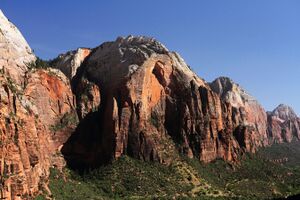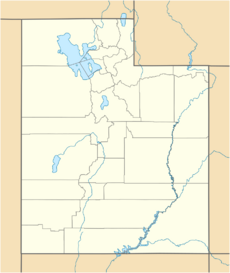Earth:Red Arch Mountain
| Red Arch Mountain | |
|---|---|
 North aspect, from Angels Landing Trail, July 2019 | |
| Highest point | |
| Elevation | 5,930 ft (1,810 m) [1] |
| Prominence | 210 ft (64 m) [1] |
| Parent peak | The Great White Throne (6,744 ft)[1] |
| Isolation | 0.60 mi (0.97 km) [1] |
| Coordinates | [ ⚑ ] : 37°15′19″N 112°56′56″W / 37.2551393°N 112.9487721°W [2] |
| Geography | |
| Location | Zion National Park Washington County, Utah United States |
| Parent range | Colorado Plateau |
| Topo map | USGS Temple of Sinawava |
| Geology | |
| Age of rock | Jurassic |
| Type of rock | Navajo sandstone |
Red Arch Mountain is a 5,930-foot (1,810 m) elevation Navajo Sandstone summit located in Zion National Park, in Washington County of southwest Utah, United States.[2]
Description
Red Arch Mountain is situated immediately northeast of Zion Lodge, towering 1,700 feet (520 meters) above the lodge and the floor of Zion Canyon. It is set on the east side of the North Fork Virgin River which drains precipitation runoff from this mountain. Its neighbors include Mount Majestic, Cathedral Mountain, The Great White Throne, Mountain of the Sun, Mount Moroni, and Lady Mountain. This mountain's descriptive name was officially adopted in 1934 by the U.S. Board on Geographic Names.[2] It is so named for a blind arch that formed in 1880 on the northwest face when a rock avalanche fell into the valley.[3] This event buried the Gifford farm in rubble. It happened on a Sunday when the family was away at church in Springdale.[4]
Climate
Spring and fall are the most favorable seasons to visit Red Arch Mountain. According to the Köppen climate classification system, it is located in a Cold semi-arid climate zone, which is defined by the coldest month having an average mean temperature below 32 °F (0 °C), and at least 50% of the total annual precipitation being received during the spring and summer. This desert climate receives less than 10 inches (250 millimeters) of annual rainfall, and snowfall is generally light during the winter.[5]
Gallery
See also
- List of mountains in Utah
- Geology of the Zion and Kolob canyons area
- Colorado Plateau
References
- ↑ 1.0 1.1 1.2 1.3 "Red Arch Mountain - 5,930' UT". https://listsofjohn.com/peak/23002. Retrieved 2020-09-06.
- ↑ 2.0 2.1 2.2 U.S. Geological Survey Geographic Names Information System: Red Arch Mountain
- ↑ Greer K. Chesser, Zion Canyon A Storied Land, University of Arizona Press, 2007, page 72.
- ↑ National Park Service nps.gov/zion
- ↑ "Zion National Park, Utah, USA - Monthly weather forecast and Climate data". Weather Atlas. https://www.weather-us.com/en/utah-usa/zion-national-park-climate.
External links
- Zion National Park National Park Service
- Weather forecast: Red Arch Mountain
- Red Arch Mountain rock climbing: Mountainproject.com
 |











